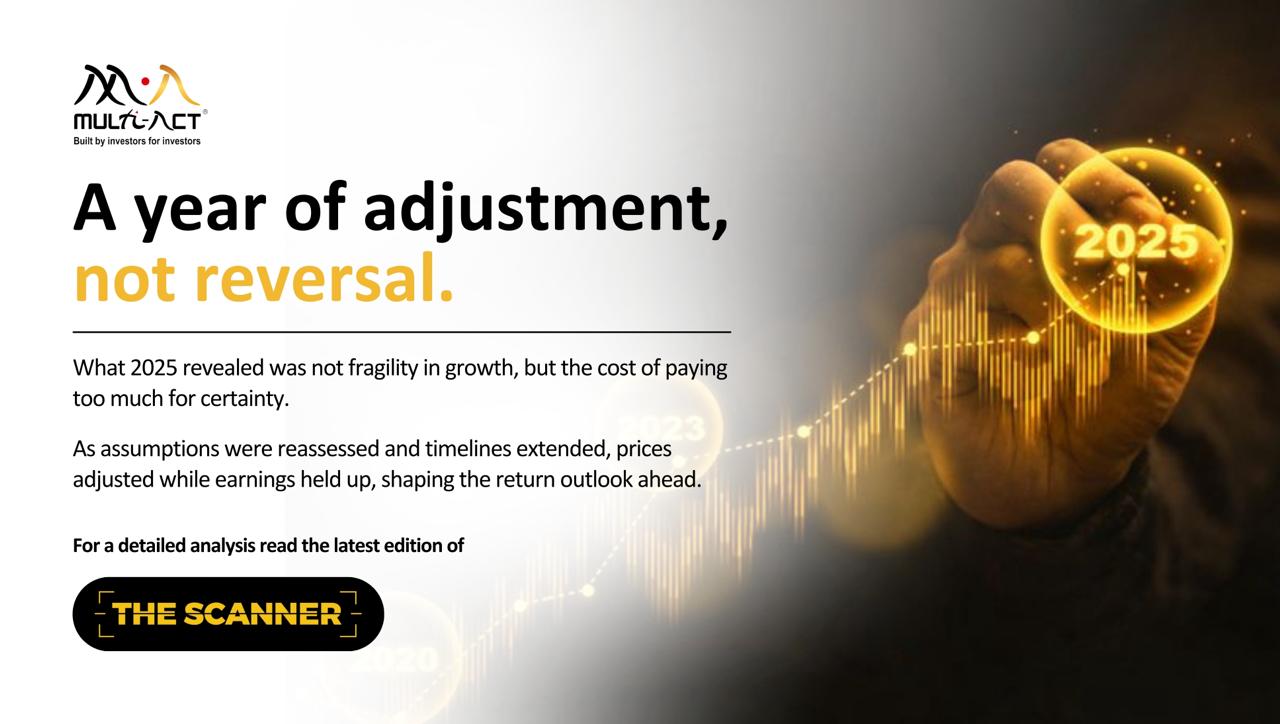
What Happened and What’s in Store for 2026
2025 did not challenge growth. It challenged assumptions. As expectations moved ahead of actual delivery, prices adjusted … Continued
Read more4 June 2024

When considering a particular company or its stock for investment, what aspects do investors assess to help build a strategic portfolio aimed at optimal returns amid minimal risk? Investors usually track a variety of metrics and subjective aspects from the company’s fundamentals to its management team and detailed outlook, before allocating their hard-earned money to the stock. For savvy and experienced investors, financial scores play a pivotal role in evaluating the performance and stability of companies across various industries. These scores serve as quantitative indicators that provide insights into a company’s financial health, risk profile, and growth potential. Among the widely used financial scores are F, M, Z, and O, each offering a unique perspective on the different aspects of a company’s operations and indicating the stock’s worthiness in being added to a well-optimised portfolio.
Assessing the Piotroski F-Score
In finance, the F-score is commonly associated with Joseph Piotroski’s scoring system, developed to assess a company’s financial strength. It uses nine criteria from the company’s financial statements to determine a score ranging from 0 to 9. Higher scores indicate stronger financial health, with a focus on profitability, leverage, liquidity, source of funds, and operating efficiency.
A commendable case study demonstrating the practical application of the F-Score in investment decisions involves Ford, which faced significant financial challenges after the 2008 financial crisis. However, by implementing restructuring initiatives with enhanced financial metrics, the company witnessed an upward trend in its Piotroski Score. Astute fundamental analysts monitoring this increasing score could have identified Ford as a potential turnaround opportunity. Consequently, over subsequent years, Ford experienced a resurgence in its stock price, rewarding those who recognised its improving financial health, as indicated by the improving F-score[1].
Understanding the Beneish M-Score
The M-score is commonly associated with the Messod Beneish M-Score, a model designed to uncover earnings manipulation or financial fraud within a company’s financial records. It aggregates various financial ratios and eight indicators to produce a single score, with higher scores suggesting a greater likelihood of manipulation. According to Beneish, companies demonstrating high sales growth, decreasing gross margins, rising leverage, and escalating operating expenses may be prone to manipulating profits by inflating cost deferrals, reducing depreciation, accelerating sales recognition, and increasing accruals.
A real-world example illustrating the relevance of the M-Score in uncovering fraudulent practices dates back to 1998 when a group of business students from Cornell University employed the model to forecast potential earnings manipulation by Enron Corporation. At that time, Enron’s stock was trading at approximately half its eventual peak price of USD 90 per share before its notorious collapse and subsequent bankruptcy in 2001. Despite the cautionary advice from the Cornell students, their warnings went unheeded on Wall Street, leading to significant financial turmoil for Enron and its stakeholders[2].
Decoding the Altman Z-Score
The Z-score, a statistical measure developed by Edward Altman in the 1960s, serves as a tool to predict bankruptcy risk in companies. It uses five financial ratios and indicators to evaluate a company’s financial health, categorising it as either safe or distressed. Companies with lower Z-scores are deemed to be at higher risk of bankruptcy.
For example, Dunlop Rubber Company (India) Limited, established in 1926, began facing challenges in 2005, leading to operations ceasing at its Sahaganj factory. Upon assuming control, the Ruia Group inherited liabilities exceeding INR 650 crores. A few years later, the Calcutta High Court ordered the company’s liquidation. Throughout this period, the company’s poor performance ratios reflected an unstable Z-score, signalling potential bankruptcy well before the court’s ruling[3].
Analysing the O-Score
While the O-score lacks a widely recognised standard meaning in finance or statistics, it is typically associated with the financial model developed by Dr. James Ohlson for predicting bankruptcy. It is derived from a nine-factor linear combination of coefficient-weighted accounting ratios extracted from financial disclosure statements provided by publicly traded companies. This model is presented as a potential alternative to the Altman Z-score for assessing financial distress. The Ohlson O-score is commonly utilised by investors looking for companies with strong short-selling potential due to their underlying weaknesses.
In conclusion, financial scores are indispensable tools for investors looking to navigate the complex landscape of investment decisions, as is evident from their real-life applications. From the Piotroski F-Score to the Beneish M-Score, Altman Z-Score, and Ohlson O-Score, each metric offers unique insights into a company’s financial health, risk factors, and potential for growth or decline. By leveraging these quantitative indicators alongside qualitative assessments, investors can make informed decisions to construct well-optimised portfolios that balance returns with risk mitigation. Understanding the meanings and applications of these financial scores empowers investors to assess company performance accurately, identify potential opportunities or pitfalls, and ultimately enhance their investment strategies for long-term success.
This article aims to delve deeper into the meanings and applications of these financial scores, offering investors a comprehensive understanding of their significance in assessing company performance and mitigating investment risks.

2025 did not challenge growth. It challenged assumptions. As expectations moved ahead of actual delivery, prices adjusted … Continued
Read more
Macro numbers alone rarely tell the full story. When jobs, consumption, credit, and inflation are considered together, … Continued
Read more
The AI story everyone sees is technological. The story that a few notice is financial. Revolving expenditures, … Continued
Read moreReceive monthly updates by signing up to our newsletter.
| Sr. No. | Received from | Pending at the end of last month | Received | Resolved* | Total Pending # | Pending complaints > 3 months | Average Resolution time^ (in days) |
|---|---|---|---|---|---|---|---|
| 1 | Directly from Investors | 0 | 0 | 0 | 0 | 0 | 0 |
| 2 | SEBI (SCORES) | 0 | 0 | 0 | 0 | 0 | 0 |
| 3 | Other Sources (if any) | 0 | 0 | 0 | 0 | 0 | 0 |
| Grand Total | 0 | 0 | 0 | 0 | 0 | 0 | |
Number of complaints received during month against the IA due to impersonation by some other entity: Nil
Note: In case of any complaints received against the IA due to impersonation of the IA by some other entity, the IA may adjust the number of such complaints from total number of received/resolved complaints while preparing the above table. Further, IA must close such impersonation related complaints after following the due process as specified by SEBI/ IAASB.
* Inclusive of complaints of previous months resolved in the current month.
# Inclusive of complaints pending as on the last day of the month.
^ Average Resolution time is the sum total of time taken to resolve each complaint in days, in the current month divided by total number of complaints resolved in the current month.
| Sr. No. | Month | Carried forward from previous month | Received | Resolved* | Pending# |
|---|---|---|---|---|---|
| 1 | April, 2025 | 0 | 0 | 0 | 0 |
| 2 | May, 2025 | 0 | 0 | 0 | 0 |
| 3 | June, 2025 | 0 | 0 | 0 | 0 |
| 4 | July, 2025 | 0 | 0 | 0 | 0 |
| 5 | August, 2025 | 0 | 0 | 0 | 0 |
| 6 | September, 2025 | 0 | 0 | 0 | 0 |
| 7 | October, 2025 | 0 | 0 | 0 | 0 |
| 8 | November, 2025 | 0 | 0 | 0 | 0 |
| 9 | December, 2025 | 0 | 0 | 0 | 0 |
| Grand Total | 0 | 0 | 0 | 0 | |
* Inclusive of complaints of previous months resolved in the current month.
# Inclusive of complaints pending as on the last day of the month.
| SN | Year | Carried forward from previous year | Received | Resolved* | Pending# |
|---|---|---|---|---|---|
| 1 | 2021-22 | 0 | 0 | 0 | 0 |
| 2 | 2022-23 | 0 | 0 | 0 | 0 |
| 3 | 2023-24 | 0 | 0 | 0 | 0 |
| 4 | 2024-25 | 0 | 0 | 0 | 0 |
| Grand Total | 0 | 0 | 0 | 0 | |
* Inclusive of complaints of previous years resolved in the current year.
# Inclusive of complaints pending as on the last day of the year.